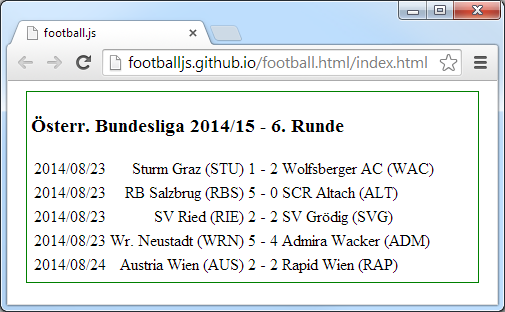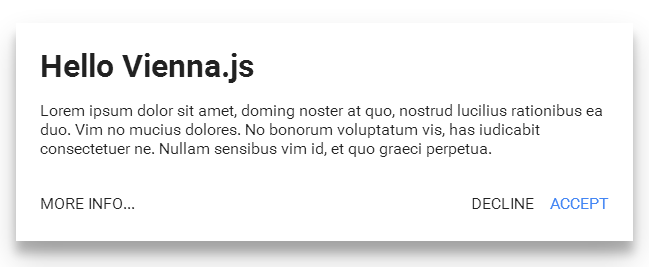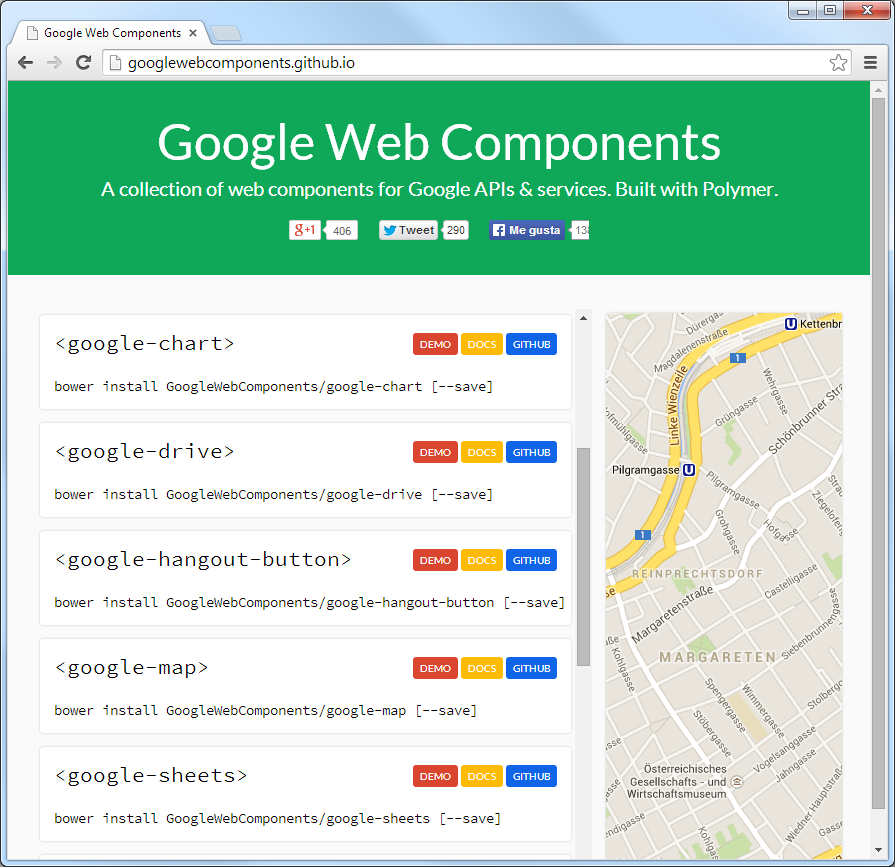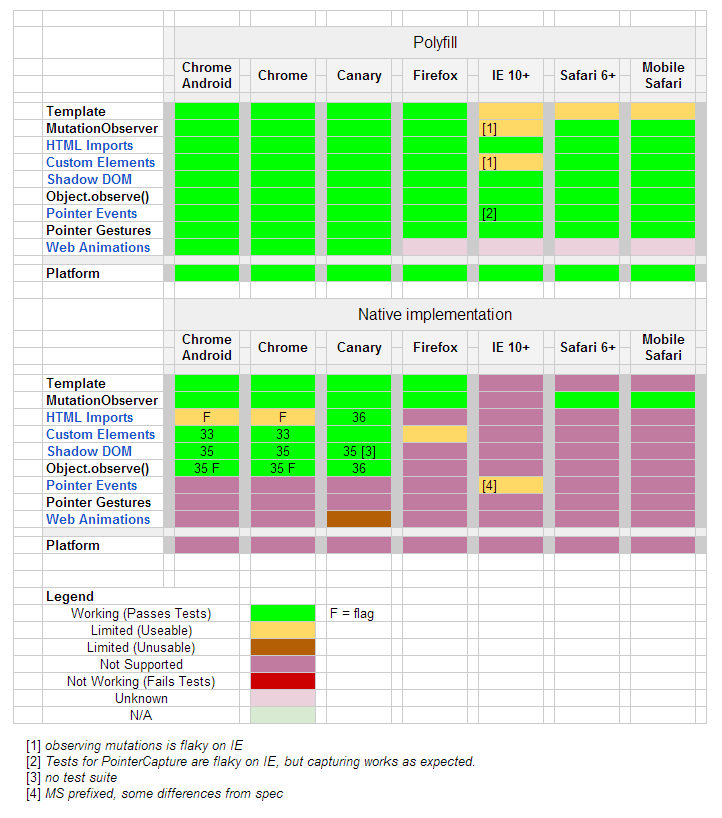Building Your Own Web Components (Tags / Elements)
Agenda
- What’s a web component? What’s a custom tag? What’s a custom element?
- Web Components Machinery - New Web Standard Building Blocks
- What’s X-Tag? What’s Polymer?
- Example 1 -
<beer-of-the-day> - Example 2 -
<football-matchday event='at.2014/15'>
<beer-of-the-day> - Use or Build Your Own Web Component (Tag / Element)
- What’s a web component?
- What’s a custom tag?
- What’s a custom element?
Web Component == Tag == Element
e.g. => <beer-of-the-day>, <football-matchday>, <super-button>
Web components machinery lets you
build your own HTML tags that you can use as easily as plain old <div> or <span> tags.
<football-matchday> - Use or Build Your Own Web Component (Tag / Element) - Example
Step 1: Import element definition into your page using an HTML import (<link rel='import'>)
<link rel='import' href='football-matchday.html'>
Step 2: Use the new element; once imported the new <football-matchday> element
is a first-class HTML element; use like any other
<football-matchday event='at.2014/15'></football-matchday>

Trivia Quiz - How many builtin standard elements (tags) has HTML 4.1? HTML 5?
A) – 50+ ?
B) – 100+ ?
C) – 200+ ?
D) – 500+ ?
E) – 1,000+ ?
F) – 10,000+ ?
All HTML 5 Elements (A-Z)
A
<a>
<abbr>
(x)<acronym>
<address>
(x)<applet>
<area>
(5)<article>
(5)<aside>
(5)<audio>
B
<b>
<base>
(x)<basefont>
(5)<bdi>
<bdo>
(x)<bgsound>
(x)<big>
(x)<blink>
<blockquote>
<body>
<br>
<button>
C
(5)<canvas>
<caption>
(x)<center>
<cite>
<code>
<col>
<colgroup>
D
(5)<data>
(5)<datalist>
<dd>
<del>
(5)<details>
<dfn>
<dialog>
(x)<dir>
<div>
<dl>
<dt>
E
<em>
(5)<embed>
F
<fieldset>
(5)<figcaption>
(5)<figure>
(x)<font>
(5)<footer>
<form>
(x)<frame>
(x)<frameset>
G H
<h1>
<h2>
<h3>
<h4>
<h5>
<h6>
<head>
(5)<header>
(x,5)<hgroup>
<hr>
<html>
I
<i>
<iframe>
<img>
<input>
<ins>
(x)<isindex>
J K
<kbd>
(5)<keygen>
L
<label>
<legend>
<li>
<link>
(x)<listing>
M
(5)<main>
<map>
(5)<mark>
(x)<marquee>
(5)<menu>
(5)<menuitem>
<meta>
(5)<meter>
N
(5)<nav>
(x)<nobr>
(x)<noframes>
<noscript>
O
<object>
<ol>
<optgroup>
<option>
(5)<output>
P
<p>
<param>
(5)<picture>
(x)<plaintext>
<pre>
(5)<progress>
Q
<q>
R
(5)<rp>
(5)<rt>
(5)<ruby>
S
<s>
<samp>
<script>
(5)<section>
<select>
<small>
(5)<source>
(x)<spacer>
<span>
(x)<strike>
<strong>
<style>
<sub>
(5)<summary>
<sup>
T
<table>
<tbody>
<td>
<textarea>
<tfoot>
<th>
<thead>
(5)<time>
<title>
<tr>
(5)<track>
(x)<tt>
U
<u>
<ul>
V
<var>
(5)<video>
W
(5)<wbr>
X Y Z
(x)<xmp>
(x) => do NOT use; non-standard, obsolete, or deprecated HTML elements
(5) => new in HTML 5
Welcome to the Web Components Revolution!
Now imagine a world with
100,000+ HTML elements (tags)
or with
1,000,000+ HTML elements (tags)
<super-button> - Use or Build Your Own Web Component (Tag / Element) - More Examples
<super-button></super-button>
<google-map lat='37.79' long='-122.390'></google-map>
<you-tube-video imfeelinglucky='rock me amadeus'></yout-tube-video>
<pdf-js src='wien.pdf'></pdf-js>
<marked-js>
## Markdown Renderer
* code in `JavaScript`
* realtime formatting
_many_ more goodies.
</marked-js>
Q: What about namespaces? How’s a custom element different from a built-in standard element
e.g. <div>, <span>?
A: Custom elements MUST use a dash (-) e.g. <beer-of-the-day>, <football-matchday>, <super-button>.
Paper Elements (Material Design) - “Real World” Web Components
Introduced to the World at the Google I/O 2014 Conference
<paper-button>
<paper-checkbox>
<paper-dialog-transition>
<paper-dialog>
<paper-fab>
<paper-focusable>
<paper-icon-button>
<paper-input>
<paper-item>
<paper-menu-button-overlay>
<paper-menu-button>
<paper-progress>
<paper-radio-button>
<paper-radio-group>
<paper-ripple>
<paper-shadow>
<paper-slider>
<paper-tab>
<paper-tabs>
<paper-toast>
<paper-toggle-button>
Usage:
<paper-dialog heading='Hello Vienna.js'>
<p>Lorem ipsum ....</p>
<paper-button label='More Info...' dismissive></paper-button>
<paper-button label='Decline' affirmative></paper-button>
<paper-button label='Accept' affirmative autofocus></paper-button>
</paper-dialog>

Google Web Components - “Real World” Web Components (Cont.)
More info @ github.com/GoogleWebComponents

Web Components Machinery - New Web Standard Building Blocks
New (Built-in) Browser Machinery
HTML Templates
(<template>) - W3C Spec
Custom Elements
(<element>) - W3C Spec
HTML Imports
(<link rel='import'> - include and (re)use HTML documents in other HTML documents) - W3C Spec
Shadow DOM
(createShadowRoot() - DOM trees inside DOM trees; hide DOM trees under shadow roots) - W3C Spec
CSS Scoping Module Level 1

Higher-Level Machinery (w/ JavaScript Libraries)
MDV (Model Driven Views)
(repeat='{{ greetings }}') - JavaScript Library for two-way databinding (incl. auto-updates w/ change observers ‘n’ more)
Web Components Machinery - New Web Standard Building Blocks - Can I Use?
Tl;dr:
Chrome 36+ ships all the web components machinery (built into the browser and turned on by default)
Firefox ships “lite” web components machinery (shipping HTML Templates and Custom Elements; NOT shipping (in development) Shadow DOM and HTML Imports)

(Source: Polymer Browser Compatibility)
Web Components Machinery - New Web Standard Building Blocks - Can I Use?
HTML Templates (<template>) - Standard
- Shipped by Chrome (and Opera) - Stable
- Shipped by Firefox - Stable
- Shipped by Safari (8+) - Stable (?)
- Under consideration by Internet Explorer (Status: Public support) - Maybe in 2017?
caniuse.com/#feat=template

Custom Elements (<element>) - Work-In-Progress
- Shipped by Chrome (and Opera) - Stable
- Shipped by Firefox - Some Bugs (Flag Required -
dom.webcomponents.enabled) - Under consideration by Internet Explorer (Status: Mixed public signals) - Maybe in 2020?
- Not supported by Safari (Status: Mixed public signals) - Who knows when or what?
caniuse.com/#feat=custom-elements
Shadow DOM (createShadowRoot(), Scoped CSS) - Work-In-Progress
- Shipped by Chrome (and Opera) - Stable
- In Development by Firefox
- Under consideration by Internet Explorer (Status: Mixed public signals) - Maybe in 2020?
- Not supported by Safari (Status: Mixed public signals) - Who knows when or what?
caniuse.com/#feat=shadowdom
HTML Imports (<link rel='import' href='x-tag.html'>) - Work-In-Progress
- Shipped by Chrome (and Opera) - Stable
- In Development by Firefox
- Under consideration by Internet Explorer (Status: Mixed public signals) - Maybe in 2020?
- Not supported by Safari (Status: No public signal) - Who knows when or what?
- caniuse.com/#feat=imports
Web Compontens Machinery - Industry (Browser) News / Support
The Good - Google, Mozilla
Google I/O 2014 - Paper Elements ‘n’ Material Design => Google wants you to build web apps (running anywhere e.g. desktop, tablet, phone) - everything in HTML/CSS/JS.
Firefox OS => Mozilla wants you to build mobile web apps for Firefox OS - everything in HTML/CSS/JS.
The Bad ‘n’ Ugly - Apple, Microsoft
No news. No suprise. Apple wants you to build iOS apps (Cocoa/ObjectiveC) and Microsoft wants you to build - suprise, suprise - Windows apps (Win32/.NET/WinRT/C#) first.
What’s X-Tag? What’s Polymer?
X-Tag
Small JavaScript library by Mozilla - lets you use and build custom tags for all modern browsers (in theory; in practice looks like an orphan - last news update (blog post) dated June 15th, 2013, that is, more than a year ago; github repo about two commits per month (!))
More info @
x-tags.org ‘n’
github.com/x-tag
Polymer
Library by Google - lets you use and build custom tags; uses web components machinery built into modern browsers; (ugly) pollyfills for older browsers.
More info @
www.polymer-project.org ‘n’
github.com/polymer

Example 1 - <beer-of-the-day> Tag Definition
beer-of-the-day.html
<polymer-element name='beer-of-the-day'>
<style>
p { background-color: yellow; }
</style>
<template>
<p>I'm a fan of <b>Ottakringer Wiener Original</b>
and this is my Shadow DOM.
</p>
</template>
<script>
<!-- no JavaScript needed for now;
sorry ;-)
-->
</script>
</polymer-element>
Example 1 - <beer-of-the-day> Tag Usage
<html>
<head>
<!-- 1. Shim/polyfill missing web components machinery -->
<script src='js/libs/polymer-min.js'></script>
<!-- 2. Load custom tag (e.g HTML Imports in action) -->
<link rel='import' href='beer-of-the-day.html'>
</head>
<body>
<!-- 3. Use custom tag -->
<beer-of-the-day></beer-of-the-day>
</body>
</html>
Example 2 - <football-matchday> Österr. Bundesliga Matchday Widget
What’s football.js?
Football widgets in JavaScript using the football.db HTTP JSON(P) API
The old way in JavaScript. Usage Example:
<script src='js/football.js'></script>
<div id='bl'></div>
<script>
MatchdayWidget.create( '#bl', { event: 'at.2014/15' } );
</script>
The new way:
<!-- step 1: HTML Imports -->
<link rel='import' href='football-matchday.html'>
<!-- step 2: use custom tag -->
<football-matchday event='at.2014/15'></football-matchday>
Example 2 - <football-matchday> - MDV (Model Driven Views)
Matchday Data as JavaScript Objects
{
"event":{"key":"at.2014/15","title":"Österr. Bundesliga 2014/15"},
"round":{"pos":6,"title":"6. Runde","start_at":"2014/08/23","end_at":"2014/08/24"},
"games":[{"team1_title":"Sturm Graz","team1_code":"STU","team2_title":"Wolfsberger AC","team2_code":"WAC","play_at":"2014/08/23","score1":1,"score2":2},
{"team1_title":"RB Salzbrug","team1_code":"RBS","team2_title":"SCR Altach","team2_code":"ALT","play_at":"2014/08/23","score1":5,"score2":0},
{"team1_title":"SV Ried","team1_code":"RIE","team2_title":"SV Grödig","team2_code":"SVG","play_at":"2014/08/23","score1":2,"score2":2},
{"team1_title":"Wr. Neustadt","team1_code":"WRN","team2_title":"Admira Wacker","team2_code":"ADM","play_at":"2014/08/23","score1":5,"score2":4},
{"team1_title":"Austria Wien","team1_code":"AUS","team2_title":"Rapid Wien","team2_code":"RAP","play_at":"2014/08/24","score1":2,"score2":2}]
}
<template>
<div class='football-widget'>
<h3>
{{ data.event.title }} - {{ data.round.title }}
</h3>
</div>
</template>
Example 2 - <football-matchday> Widget - Nested Templates
<template>
<div class='football-widget'>
<h3>
{{ data.event.title }} - {{ data.round.title }}
</h3>
<table>
<template repeat='{{data.games}}'>
<tr>
<td>
{{ play_at }}
</td>
<td style='text-align: right;'>
{{ team1_title }} ({{ team1_code }})
</td>
<td>
{{ score1 }} - {{ score2 }}
</td>
<td>
{{ team2_title }} ({{ team2_code }})
</td>
</tr>
</template>
</table>
</template>
Example 2 - <football-matchday> - All Together Now
<polymer-element name='football-matchday' attributes='event'>
<template>
<style>
.football-widget {
border: 1px solid green;
padding: 4px;
margin: 10px;
}
</style>
<div class='football-widget'>
<h3>
{{ data.event.title }} - {{ data.round.title }}
</h3>
<table>
<template repeat='{{data.games}}'>
<tr>
<td>
{{ play_at }}
</td>
<td style='text-align: right;'>
{{ team1_title }} ({{ team1_code }})
</td>
<td>
{{ score1 }} - {{ score2 }}
</td>
<td>
{{ team2_title }} ({{ team2_code }})
</td>
</tr>
</template>
</table>
</div>
</template>
<script>
Polymer('football-matchday', {
// event: 'at.2014/15',
data: {
"event":{"key":"at.2014/15","title":"Österr. Bundesliga 2014/15"},
"round":{"pos":6,"title":"6. Runde","start_at":"2014/08/23","end_at":"2014/08/24"},
"games":[{"team1_title":"Sturm Graz","team1_code":"STU","team2_title":"Wolfsberger AC","team2_code":"WAC","play_at":"2014/08/23","score1":1,"score2":2},
{"team1_title":"RB Salzbrug","team1_code":"RBS","team2_title":"SCR Altach","team2_code":"ALT","play_at":"2014/08/23","score1":5,"score2":0},
{"team1_title":"SV Ried","team1_code":"RIE","team2_title":"SV Grödig","team2_code":"SVG","play_at":"2014/08/23","score1":2,"score2":2},
{"team1_title":"Wr. Neustadt","team1_code":"WRN","team2_title":"Admira Wacker","team2_code":"ADM","play_at":"2014/08/23","score1":5,"score2":4},
{"team1_title":"Austria Wien","team1_code":"AUS","team2_title":"Rapid Wien","team2_code":"RAP","play_at":"2014/08/24","score1":2,"score2":2}]
}
});
</script>
</polymer-element>
Example 2 - <football-matchday> - Usage
<!DOCTYPE html>
<html>
<head>
<meta charset='utf-8'>
<title>football.js</title>
<script src='js/libs/polymer.min.js'></script>
<link rel='import' href='football-matchday.html'>
</head>
<body>
<football-matchday event='at.2014/15'></football-matchday>
</body>
</html>

That’s it.
Appendix: Web Components Machinery - New Web Standard Building Blocks - Sources
Chrome
Firefox
- Bugzilla pages
Internet Explorer
Site source on github (creative commons licensed) build w/ Node.js; modern IE ?! - is this possible? - IE and modern?
Apple
- Secrets, Secrets, Secrets - Who knows when or what?
Appendix: New Anti-Pattern? Single Web Component App <my-beer-app>
<!DOCTYPE html>
<html>
<head>
<title>My Beer App</title>
<link rel='import' href='my-beer-app.html'>
</head>
<body>
<my-beer-app>
</body>
</html>
Anti-Pattern? Why? Why Not?
Appendix: Vanilla JS Example - HTML5 Rocks Article Series
HTML5 Rocks Series
- HTML’s New Template Tag: Standardizing client-side templating by Eric Bidelman (Google); February 26th, 2013 (Updated: December 18th, 2013)
- Custom Elements: Defining new elements in HTML by Eric Bidelman (Google); August 28th, 2013 (Updated: December 18th, 2013)
- Shadow DOM 101 by Dominic Cooney (Google); January 4th, 2013 (Updated: December 18th, 2013)
- Shadow DOM 201: CSS and Styling by Eric Bidelman (Google); March 15th, 2013 (Updated: April 10th, 2014)
- Shadow DOM 301: Advanced Concepts & DOM APIs by Eric Bidelman (Google); March 21st, 2013 (Updated: December 18th, 2013)
- HTML Imports: #include for the web by Eric Bidelman (Google); November 11th, 2013 (Updated: December 18th, 2013)
Appendix: Vanilla JS Example - Register a Custom Web Element
var proto = Object.create(HTMLElement.prototype);
proto.createdCallback = function() {
this.textContent = 'I'm an x-foo!';
};
proto.foo = function() {
console.log('foo() called');
};
var XFoo = document.registerElement('x-foo', {
prototype: proto
});
Now use like:
var xfoo = new XFoo(); // or
var xfoo = document.createElement('x-foo');
document.body.appendChild( xfoo );
or
<x-foo> <!-- OMG! It's HTML! -->
